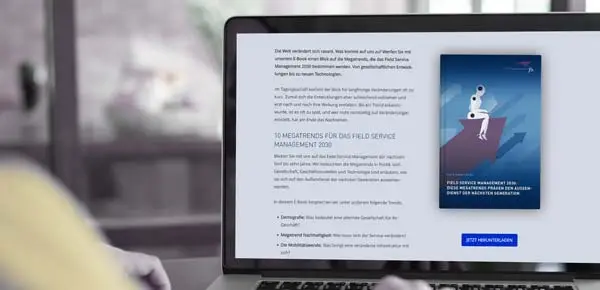
BLOG / SOLUTIONS · IMPROVE FIELD SERVICE
INVEST NOW TO IMPROVE FIELD SERVICE OPERATIONS
19 September 2022 · James Alex Waldron
Overall, in times of competitor mergers and acquisitions, field service operators are recognising the focus toward the importance of long-term customer loyalty. After all, it is five times more expensive to win a new contract with cut-prices, than to retain an existing contract.
Funding for further business development and improvement usually flows into marketing and sales departments, which can be convincing with presentations and example campaigns. The service department on the other hand, is often left empty-handed - although successful customer retention and word-of-mouth/case studies would not be possible without it.
INVESTING IN FIELD SERVICE - A TASK BECOMES AN OPPORTUNITY
This imbalance in investment is sometimes due to C-Level management not being aware of how complex field service processes can be. They are not familiar with how much effort it takes to provide reliable, in-person operations. At the same time, they may not be aware of real-terms benefits and opportunities of investing in this area.So it's up to you as a service manager, project lead, or IT architecture professional to make management understand the importance of investing in medium to long-term service improvements.
ACTION 1
THE CHANGE OF PERSPECTIVE: CONSIDERING THE WORLD OF DECISION-MAKERS
Leaders and managers must deal with a multitude of concerns as business progresses, every day. As a result they make numerous decisions, often within an annual budget, and cannot agree to every proposal. Therefore, ask yourself the following questions from their perspective:- What is at the core of your concern?
- What is the importance of your concern for the company?
- Why should people listen to you right now?
- What do you want management to do and what support will you need from them?
ACTION 2
QUANTIFYING THE ADDED VALUE: ROI AND KPI
'This could mean big savings for the company.'versus 'This saves us £45,000 a year.'
Which pitch sounds more sensible to you? Concrete data helps decision-makers to understand the importance of an investment in field service for the company. Therefore, you should back up each of your concerns with researched, tangible figures.
The best way to do this, apart from the concrete monthly or annual savings, is the return on investment (ROI). How long will the investment have paid for itself and thus only bring the company additional profit? The shorter and more sustainable this period is, the more wholeheartedly a C-Level will approve the actions towards investment.
Also consider which Key Performance Indicators (KPI) in the service you want to improve through the investment. If you must optimise these with the help of new software, engage the vendors early. No business is alike, but what is typical to your size, contract servicing, and sector; what improvement you can expect in the medium and long term. For example, you can have your potential for improvement determined very specifically through a Scheduling Test.
ACTION 3
THE HOLISTIC PROPOSAL: HIGHLIGHTING BENEFITS FOR ALL AREAS
The benefits of investing in field service are not only evident through improving the hard numbers. They also strengthen the soft factors such as the working atmosphere and employee satisfaction. Moreover, not only the service operations benefit, but often other support departments as well:- Modern work equipment and optimised work processes increase employee satisfaction.
- Satisfied employees perform better and generate more revenue.
- High employee satisfaction is a good argument for applicants and reduces costs in HR and recruiting.
- Shorter response times, better accessibility and a first-time-fix increase customer satisfaction and loyalty.
- Satisfied customers bring reliable sales and the company requires less marketing budget to attract new customers or to retain contracts.
ACTION 4
SEEK ALLIES: EMPHASISE CROSS-DEPARTMENTAL BENEFITS
With the argument that an investment in dynamic field service creates relief for other departments, you can also look for and win allies outside your own department. After all, sales, marketing, or HR should have little objection if they benefit because you now have the digital tools do your job better.With several other departments behind you, you have a good chance that the next investment will actually be approved. And if you are in talks with your neighbouring departments anyway, software solutions and investments can also be designed with improve cooperation within the company. How else will you prepare your 'MoSCoW' documentation? (Must have, Should have, Could have, and Won't have).
A service that is well connected with all areas is much more efficient than one that always has to search for the right contact person to solve the customer's problems. The trend of a holistic solution that connect departments and their processes with each other is not going away.
ACTION 5
HIGHLIGHTING THE CONSEQUENCES OF A LACK OF INVESTMENT
No matter how many evidenced arguments you put present in your proposal, in the end, investment in field services can be met with 'we have technicians/operatives on the road today and a busy call centre - where's the problem'. Especially in times of economic depression, such projects are often postponed due to uncertain future prospects - and then all too often disappear from the agenda altogether.By reversing the argument you can prevent such 'delaying tactics'. Ask yourself (and your decision maker) not only; 'What can we gain?' but also 'What will happen if we do not invest in the field service now?'.
An argument could look like:
- Long waiting times and inadequate field services reduce customer satisfaction.
- The company is no longer competitive in an increasingly service-oriented market.
- Declining customer satisfaction leads to the loss of regular customers.
- Marketing and sales needs more money to attract new customers.
- Internal support departments face increasing workloads and cost risk increases for the whole business.
- Data and feedback collection methods are increasingly old-fashioned and the business 'doesn't know what it doesn't know'.
START YOUR JOURNEY TO IMPROVE FIELD SERVICE OPERATIONS
To gain an understanding of tools to optimise the field experience for your workforce and customers book a short discussion or contact us at info@fastleansmart.com.Read more:
5 actions to improve Customer Experience in Field Service
Scheduling: Key to a Workforce Management Ecosystem
Route planning SaaS: Your competitive advantage
Cost control: Reactive maintenance with Field Service Management software

JAMES ALEX WALDRON
UK Marketing Manager
+44(0) 1183 800189
Send email
James Alex Waldron has worked in written communications for over 10 years. Since 2021, he has written for FLS and the Solvares Group on the topics of digital field service transformation and mobile workforce management, and regularly provides insight to the industry press.




